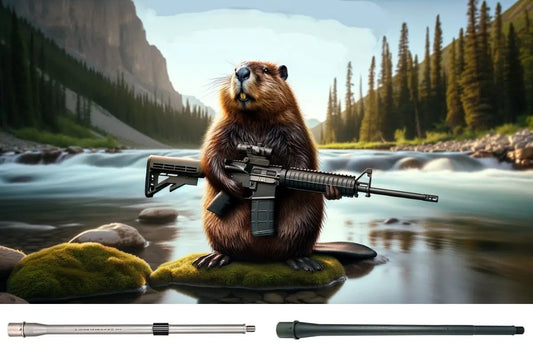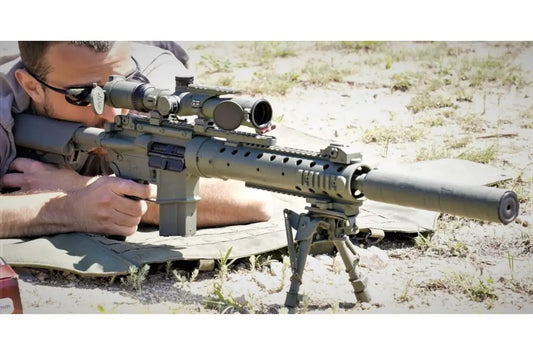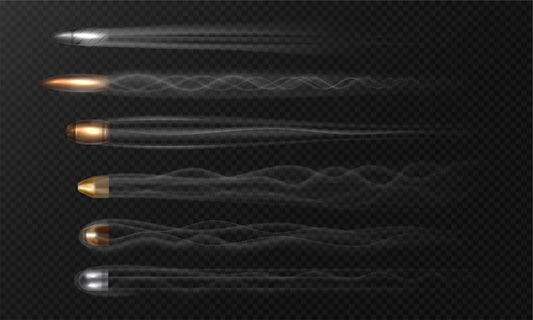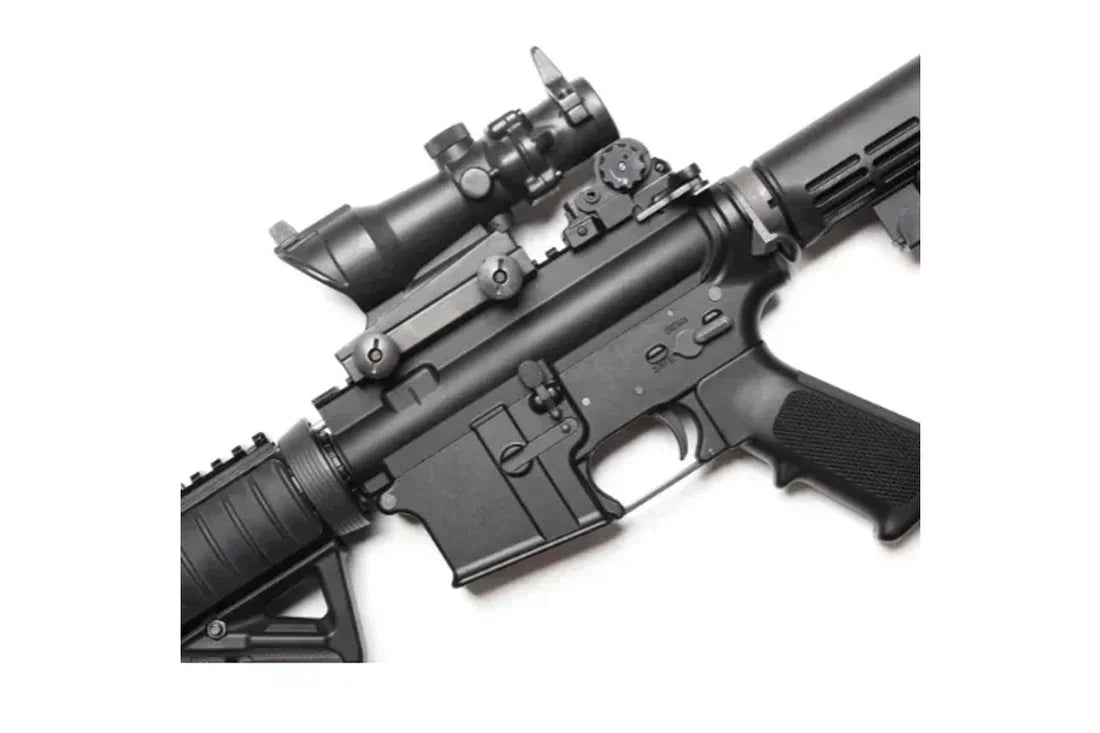
Piston vs. DI AR-15, Demystified: A No-BS 2025 Buyer’s Guide to Picking the Right Gas System
TL;DR for Skimmers
- General-purpose 16″ 5.56, unsuppressed: DI wins on weight, cost, parts compatibility, and accuracy potential.
- Short barrels and heavy suppressor use: Piston tends to be cleaner at the carrier and easier to tune across ammo/suppressor combos (especially short-stroke or long-stroke systems with adjustable gas).
- “One rifle to do everything” without tinkering: Consider modern piston rifles (SIG MCX SPEAR LT, PWS MK116) or a well-tuned DI with an adjustable gas block and H3/A5 buffer if you’re willing to tune.
Quick-Chooser Table
|
Use case / priority |
Pick |
Why (in one sentence) |
|
16″ 5.56 do-all rifle, mostly unsuppressed |
DI |
Lighter, cheaper, simpler; tons of parts support and excellent accuracy potential. |
|
Precision/competition on 18″ |
DI |
Generally, edges piston for mechanical accuracy and barrel harmonics. |
|
10.3″–12.5″ SBR, suppressed a lot |
Piston (or tuned DI) |
Adjustable piston systems reduce gas-to-face and carrier heat; tuning is straightforward. |
|
Maximum modularity & “runs anywhere” duty rifle |
Modern piston |
Systems like SIG MCX SPEAR LT and LMT MARS-L Piston are built around suppression and ambi ergonomics. |
|
Budget build / first AR |
DI |
Rifle and parts are more affordable; training dollars can go to ammo and optics. |
What we’re actually comparing (and why terminology causes fights)
Direct Impingement (DI) on the AR is technically not “impingement” in the classic sense. Stoner’s design routes gas through a tube into the carrier’s expansion chamber; the bolt and carrier act as the piston and cylinder—what Stoner called a “true expanding gas system.” That’s why DI ARs can be so light and shoot so flat for their weight.
Piston ARs (short-stroke or long-stroke) tap gas at the block into a physical piston/op-rod that drives the carrier. You keep a lot of hot gas out of the receiver, you usually get an adjustable gas block by default, and the rifle tends to stay cleaner at the BCG—but the system adds parts, weight, and side loads to the carrier/upper.
Expert voice, short & sweet: “The gas impingement system is just so much more efficient.” — C. Reed Knight, Jr. (KAC). That efficiency shows up as less mass, fewer parts, and the shootability many of us like on 16″ DI guns. –SmallArmsReview.com
Pros & Cons (DI vs. Piston)
DI — Pros
- Weight & balance: Typically, ~1 lb lighter than comparable piston guns, all else equal—huge for an all-day carbine or dynamic matches.
- Accuracy potential: No external op-rod bearing on the barrel; fewer perturbations to barrel harmonics.
- Cost & ecosystem: Lowest entry cost; every part, tool, and tutorial exists for DI; you can fix anything with common spares.
- Mature, proven: The M4/M16 family remains in massive front-line service; DI is not some fragile oddity—when gassed correctly, it runs.
DI — Cons
- Gas/heat in the carrier: More blowback into the receiver, especially with cans and short barrels (but adjustable gas and proper buffers help a lot).
- Suppressed “gassy” behavior: Expect more gas-to-face unless you tune—adjustable block, vented charging handle, buffer/spring selection.
Piston — Pros
- Runs cooler/cleaner at the BCG: Less crud in the carrier; easier to keep running filthy or with heavy suppressor schedules.
- Adjustability baked in: Most quality piston guns include adjustable gas (normal/suppressed/adverse); tuning for ammo/can is explicit and fast.
- Suppressed SBRs: Many shooters find pistons less “gassy,” with more consistent ejection and less receiver fouling when you shorten barrels.
Piston — Cons
- Weight & front mass: You’re adding a block, piston, and op-rod; many piston rifles weigh several ounces to nearly a pound more than a like-for-like DI.
- Cost & proprietary parts: Buy-in and spares are pricier; you’re married to a brand’s piston pattern for bolts/op-rods/blocks.
- Accuracy edge usually goes to DI: External forces and additional moving mass can nibble at precision (less of an issue for duty carbine distances).
Historical context: Jim Sullivan (co-designer of the AR-15) noted that early M16 reliability issues were mostly powder/gas-port pressure choices—not that “DI can’t work.” The gas does dirty the bolt, so DI demands proper maintenance and correct gassing—but when it’s set up right, it’s brutally reliable. –SmallArmsReview.com
Weight, Accuracy & Cost — the practical deltas
- Weight: Expect DI carbines around ~6.1–6.8 lb naked; piston equivalents often land ~0.5–1.0 lb heavier depending on rail/barrel/gas. Primary Arms pegs a typical DI at ~6.5 lb vs. piston at ~7.4 lb; other sources routinely cite about a pound delta in similar builds. If you carry all day, you’ll feel that. –PrimaryArms.com
- Accuracy: All else equal, a free-floated DI gun preserves harmonics and generally edges piston for small groups. At 0–300 yards on steel? The difference is academic.
- Cost: Real-world pricing as of 2025: excellent DI rifles like BCM RECCE-16 typically list around $1,800; Daniel Defense DDM4 V7 around $2,000+. Tier-one pistons (e.g., SIG MCX SPEAR LT) are often around $2,600–$2,850; PWS MK116 Mod 2-M around $2,050–$2,100; LMT MARS-L Piston around $3,250.
Suppressors & Short Barrels: Where piston shines (and DI still competes)
If you’re living in the 10.3″–12.5″ suppressed world, piston rifles and uppers are hard to beat for gas control and carrier cleanliness—especially systems that offer 3+ gas positions or “bleed-off” architectures. PWS’s long-stroke (AK-style) implementation is a stand-out with a 3-position block; MCX SPEAR LT is built for suppression from the ground up with QD muzzle devices and ambi controls.
That said, a well-tuned DI—adjustable gas block (Superlative Arms “bleed-off” is excellent), appropriate buffer/spring—can be exceptional suppressed with less weight and cost. The tradeoff is that you must do the tuning.
Reliability & Heat: What the real world says
DI dumps heat at the carrier; piston dumps it at the block/piston. On a long firing schedule (classes, team training, sustained strings), piston carriers stay cleaner and cooler—but modern DI carbines with correct gas porting, buffers, and lube keep up just fine for the vast majority of users. The U.S. services’ decades-long reliance on the M4 DI platform says plenty.
On the piston side, HK’s 416 family (USMC M27 IAR) showed why piston can shine in automatic/sustained roles, but it also surfaced how gas setting choices affect bolt life and parts stress—reminder that piston isn’t magic; it’s engineering tradeoffs like everything else.
Real Rifles & Uppers We’d Recommend (high-end, vetted picks)
Top DI Carbines
- Bravo Company (BCM) RECCE-16 MCMR — Benchmark 16″ mid-length do-all carbine. Light (~6.1 lb listed), properly gassed, duty-grade barrels/BCGs, and superb QC. Street pricing often around $1,800.
- Daniel Defense DDM4 V7 — Cold-hammer-forged 16″ barrels, mid-length gas, rock-solid reliability, and good resale; think $2K+ depending on trim and market.
- Colt CR6920 — The classic “M4 pattern” DI carbine with chrome-lined barrel and correct details; still a solid baseline at roughly $1,099 MSRP.
- LMT MARS-L (DI) — Monolithic MRP upper with quick-change barrels and fully ambi lower; premium DI duty rifle at ~$2,461.
Top Piston Carbines
- SIG MCX SPEAR LT (16″ 5.56) — Built for suppression and modularity, fully ambi, fast barrel swaps; typically, ~$2,600–$2,850 street/MSRP. If you want plug-and-play suppressed performance without tinkering, this is the modern standard.
- PWS MK116 Mod 2-M (long-stroke piston) — The smoothest-shooting AR-pattern piston rifle many shooters will try; 3-position gas and excellent handguard/forging. Expect ~$2,050–$2,100.
- HK MR556A1 (HK416 DNA) — Ultra-robust short-stroke piston carbine with HK quality and weight; pricey, but the lineage is there.
- LMT MARS-L 5.56 Piston — MRP monolithic + quick-change piston barrels + ambi MARS lower. True hard-use duty gun; typically, ~$3,200–$2,500 depending on vendor.
Why these? All four piston picks include robust adjustable gas and strong factory support. The DI picks are proven, widely supported, and excellent baselines for tuning (blocks, buffers, springs) if you want to run cans later.
Retrofit: Converting DI to Piston (and should you?)
If you already own a DI rifle and want to experiment with piston behavior, two reputable options:
- Superlative Arms “Bleed-Off” Piston Kits — Rather than restricting, these bleed excess gas forward, which can mean softer recoil and less blowback suppressed. Good kits with thought-through adjustability.
- Adams Arms P-Series Kits — Well-established short-stroke conversions with adjustable gas, available in multiple lengths and profiles.
Caveat: Retrofit kits add parts and can create rail/handguard and alignment constraints you don’t get with native piston rifles; if your use-case is heavily suppressed SBR work and you want “it just runs,” a purpose-built piston rifle is usually cleaner than a retrofit. (If you enjoy tuning and already own a DI gun, conversions are a fun, educational path.)
Our take (opinionated and practical)
- If you want one do-everything 16″ 5.56 for classes, training, and home defense without a can: Buy DI—BCM or DD—and spend the saved money on ammo, a quality LPVO or red dot + magnifier, sling, and class fees. You’ll get a lighter, sweeter-shooting rifle that’s easy to maintain and upgrade.
- If you primarily shoot suppressed, especially on 11.5″–12.5″: Go piston (MCX SPEAR LT or PWS MK116). You’ll appreciate the adjustable gas and cleaner carrier. If you like tinkering and want the lightest feel, a tuned DI with a Superlative Arms block can absolutely hang—but you’ll do the homework.
- If you need a patrol/duty “just works with anything” carbine: The LMT MARS-L Piston is a tank with quick-change barrels and ambi controls; it’s expensive, but the architecture is hard to beat for institutional or hard-use roles.
Product snapshots (with real-world prices where helpful)
- BCM RECCE-16 MCMR (DI): Mid-length gas, duty barrel, Gunfighter furniture; typical new price ~$1,795.
- Daniel Defense DDM4 V7 (DI): CHF 16″ barrel, MFR 15.0 rail; $2K+ depending on finish/retailer.
- Colt CR6920 (DI): The canonical M4-pattern carbine; $1,099 MSRP direct from Colt.
- LMT MARS-L DI: Monolithic MRP upper, fully ambi; $2,861 list.
- SIG MCX SPEAR LT (Piston): Ambi controls, quick barrel swaps, suppressor-ready; common street ~$2,599.99.
- PWS MK116 Mod 2-M (Piston): Long-stroke system, 3-position gas; around $2,099.95 on PWS site.
- HK MR556A1 (Piston): Civilian HK416 lineage; premium price, premium build.
- LMT MARS-L 5.56 Piston: Factory piston MRP with ambi lower; $3,254 list on LMT’s store.
Nuance, edge cases & “gotchas” you should factor in
- Weight anxiety is sometimes overstated: Depending on contour/rail choice, piston vs. DI delta can be as little as a few ounces on some platforms—but on others it’s close to a pound. Confirm specs for your exact model.
- Bolt speed & wear are tunable variables: On both systems, gas setting, buffer mass, and spring rate control bolt velocity—and reliability. Don’t blame “DI” or “piston” broadly for what’s actually a tuning issue. (Example: early HK416 gas decisions improved reliability in short barrels but had bolt life tradeoffs in certain use cases.)
- Ecosystem matters: DI wins for part interchangeability. For piston, stick with brands with strong support (SIG, LMT, PWS, HK) to avoid orphaned proprietary spares.
Decision recipe (fast)
- Barrel length: ≥16″ and mostly unsuppressed → DI; ≤12.5″ and mostly suppressed → Piston (or meticulously tuned DI).
- Tolerance for tinkering: Hate tuning? → MCX/PWS/LMT piston. Like dialing gas and buffer? → DI with adjustable block.
- Budget & weight: If every ounce and dollar matters → DI. If “mission first” and you’ll pay for robustness/ambi/modularity → Piston.
- Future-proofing: Want cross-caliber barrel swaps and institutional support? → LMT MRP or SIG MCX ecosystems.
“But what do the experts say?”
- Reed Knight, Jr.: “The gas impingement system is just so much more efficient.” That efficiency is why top-tier DI carbines still dominate the do-all 16″ slot. –SmallArmsReview.com
- Jim Sullivan: Early M16 issues were fundamentally powder/pressure decisions; DI itself wasn’t the villain. Also, yes—the bolt gets dirty because the gas actually operates the gun. Maintain it and it runs. –SmallArmsReview.com
Example bundles that just work
- Lightweight do-all DI: BCM RECCE-16 + 1–6× LPVO + A5/H2 buffer + quality sling. You’ll finish under many piston rifles while keeping shootability and accuracy high.
- Suppressed SBR, minimal tuning: PWS MK111/MK116 or SIG MCX SPEAR LT (shorter factory options exist). Dial gas to “suppressed,” confirm ejection, done.
- Institutional/duty modularity: LMT MARS-L Piston with spare quick-change barrels (DI/piston) for role flexibility.
Final verdict
If you’re building or buying one AR and you’re not living on a suppressor, buy DI. You’ll get lighter weight, outstanding accuracy, cheap spares, and an ecosystem that never leaves you stuck. If your world is short barrels, heavy suppression, or institutional “no-tune” requirements, buy piston—the MCX SPEAR LT, PWS MK1 series, and LMT MARS-L Piston are the current high-water marks.
Both paths can be bomb-proof when you respect gas and bolt velocity. The right answer isn’t tribal; it’s use-case + tuning.
